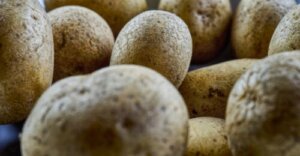Andean Chuño: Properties and Uses


Written and verified by the nutritionist Maria Patricia Pinero Corredor
Chuño is an ancient food from the Andes. It’s grown especially in Peru and Bolivia and is a crop that has been passed down through generations, recognized among farming families as a cultural heritage. Find out about Andean chuño in this article.
It’s a kind of bitter potato that can last up to 20 years. In some parts of the Andes, it’s used to replace bread and as an accompaniment to breakfast, lunch, and dinner.
Intrigued to find out more about Andean chuño? Here we’ll find out more about its properties and everything science knows about it.
What is Andean chuño?
Chuño is a bitter potato that is dehydrated under natural freezing conditions. This is why it’s also known as dehydrated potato.
It also has another nickname: millenary potato, because its origins date back to pre-Columbian times. Being a traditional food of the central indigenous communities of Bolivia and Peru, today it has spread throughout the territories of Ecuador, Chile, and Argentina.
The word “chuño” is attributed to the Quechua language, whose original word was ch’uñu and its closest translation would be “wrinkles”. The way it is made and preserved is one of the oldest in the world, being one of the central elements of the indigenous diet.
It’s currently a central part of the gastronomy of the following regions:
- Northern Chile.
- South of Ecuador.
- North of Argentina.
- South Andean region of Peru.
- Highlands of Bolivia. There is a higher consumption of chuño in the Bolivian areas of La Paz, Cochabamba, Oruro, Chuquisaca, Potosí, Tarija and Santa Cruz.
Nutritional value
Chuño has the following values per 100 grams (4 oz) of product:
- Calories: 336.54.
- Humidity: 14.11 %.
- Protein: 3.49 grams.
- Carbohydrates: 80.15 grams.
- Crude fiber: 1.70 grams.
- Ashes: 2.03 grams.
- Calcium: 16.23 milligrams.
- Phosphorus: 101.40 milligrams.
- Iron: 5 .68 milligrams.
- Niacin: 1.62 milligrams.
In addition, chuño contains vitamin B5 or pantothenic acid, vitamin A, calcium, and antioxidants. This gives it certain nutritional properties that we’ll mention below.

Properties of chuño
Now we’ll analyze in more depth the health benefits of chuño. Here are some properties.
It’s high in starch
Its high content of resistant starch makes it good for intestinal health, according to medical literature. This type of starch helps improve microbiota health, reduces body fat accumulation, improves insulin sensitivity, and regulates blood sugar.
This happens because starch, when not digested in the small intestine, reaches the colon to be fermented by the microbiota, generating gases, short-chain fatty acids, organic acids, and alcohols. In this way, it acts as a prebiotic. In addition, it provides a feeling of satiety.
In a literature review, it was found that the chuño manufacturing process increases the percentage of amylose in the total starch content. The explanation is that it is exposed to very drastic temperature changes and this allows the activation of enzymes, such as amylases, which are related to an increase in resistant starch.
Another great article for you: 5 Alternative Uses for Corn Starch that You’re Going to Love
Good source of minerals and antioxidants
When chuño is processed, there’s a loss of antioxidants and phenolic compounds, but not all of them. Some minerals are concentrated, and this is the case with phosphorus, calcium, iron and zinc.
Calcium is an important mineral in the body, as it makes up the bones and teeth. It’s obtained in 16.23 milligrams per 100 grams (4 oz) of chuño.
In addition, the production increases the phenol content, such as chlorogenic acid, protocatechuic acid, gallic acid, and epicatechin. Of all these compounds, the one found in the highest proportion is epicatechin, with 460 milligrams per 100 grams (4 oz) of dry matter.
Epicatechin is a polyphenol known for its antioxidant power. It has been shown in studies to have a superior capacity to other similar compounds.
Antioxidants are substances that prevent and neutralize free radical damage, achieving the slowing of aging.
It can help regulate blood glucose
Resistant starch can help regulate blood glucose levels. This is because it has slower digestion and is associated with a lower rise in glucose after eating.
In this regard, studies in healthy people have reported that resistant starch reduces insulin levels in the blood after meals. This is because there’s less availability of carbohydrates for absorption.

Discover more here: What Are the Warning Signs of Hyperglycemia?
How is chuño made?
Chuño has a unique and millenary elaboration process. First, the potatoes are extracted and evaluated.
Impurities and rotten potatoes are eliminated. Then they’re selected and classified by shape and size.
After that, they’re frozen. This is done by exposing them to winter temperatures of -4 to -15 degrees Celsius for 3 or 4 nights.
They’re then taken out and immersed in a river for 21 to 30 days in mesh cages. The next step is to freeze them again at the same temperature for 1 to 2 nights.
After this, comes the shelling phase. This means removing the skin and always maintaining the hygienic process.
Uses of chuño
Andean chuño used to be used in indigenous communities when there weren’t many resources to eat. Nowadays, it’s a commercialized product in several parts of the world.
It’s usually used as flour. In fact, it’s used to make cookies, as a thickener, in soups, and even in compotes. We recommend consuming it for its nutrients and starch content, which would be beneficial for gastrointestinal health.
All cited sources were thoroughly reviewed by our team to ensure their quality, reliability, currency, and validity. The bibliography of this article was considered reliable and of academic or scientific accuracy.
- Fabiola Valdivieso Molina. Formación de almidón retrogradado relacionado a niveles de amilosa en el almidón de papa (Solanum tuberosum) y chuño. Rev.Cs.Farm. y Bioq vol.9 no.2 La Paz nov. 2021 Epub 30-Nov-2021. https://doi.org/10.53287/mjns8913yn27w
- SUMILDA CALLIZAYA HUANCA. VALOR NUTRICIONAL DEL CHUÑO DE TRES VARIEDADES DE PAPA EN LA LOCALIDAD DE VIACHA, LA PAZ. 2021. https://repositorio.umsa.bo/bitstream/handle/123456789/25934/T-2902.pdf?sequence=1&isAllowed=y
- Villaroel P. Almidón resistente: Características tecnológicas e intereses fisiológicos. Rev. chil. nutr. vol.45 no.3 Santiago set. 2018. http://dx.doi.org/10.4067/s0717-75182018000400271
- Fabiola Valdivieso Molina. Formación de almidón retrogradado relacionado a niveles de amilosa en el almidón de papa (Solanum tuberosum) y chuño. Rev.Cs.Farm. y Bioq vol.9 no.2 La Paz nov. 2021 Epub 30-Nov-2021. https://doi.org/10.53287/mjns8913yn27w
- Patrón A. CARACTERIZACIÓN FUNCIONAL Y QUÍMICA DE CUATRO VARIEDADES DE CHUÑO COMERCIALIZADAS EN ESPAÑA. 2019. https://riunet.upv.es/bitstream/handle/10251/129068/Patr%C3%B3n%20-%20CARACTERIZACI%C3%93N%20FUNCIONAL%20Y%20QU%C3%8DMICA%20DE%20CUATRO%20VARIEDADES%20DE%20CHU%C3%91O%20COMERCIALIZADAS%20EN%20ESP….pdf?sequence=1&isAllowed=y
- LILIANA SOTELO C. Evaluación de epicatequina, teobromina y cafeína en cáscaras de cacao (Theobroma cacao L.), determinación de su capacidad antioxidante. rev.colomb.cienc.hortic. vol.9 no.1 Bogotá Jan./June 2015. https://doi.org/10.17584/rcch.2015v9i1.3751
- Stewart M, Zimmer J. A High Fiber Cookie Made with Resistant Starch Type 4 Reduces Post-Prandial Glucose and Insulin Responses in Healthy Adults. Nutrients 2017; 9: E237.
This text is provided for informational purposes only and does not replace consultation with a professional. If in doubt, consult your specialist.








